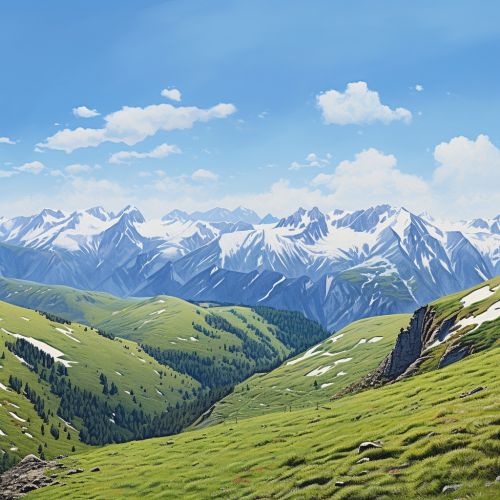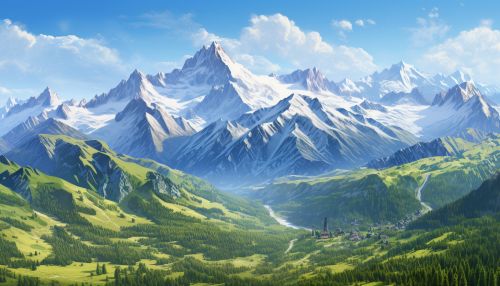Alps
Geography
The Alps are the highest and most extensive mountain range system that lies entirely in Europe, stretching approximately 1,200 kilometres (750 miles) across eight Alpine countries (from west to east): France, Switzerland, Monaco, Italy, Liechtenstein, Austria, Germany, and Slovenia. The mountains were formed over tens of millions of years as the African and Eurasian tectonic plates collided. Extreme shortening caused by the event resulted in marine sedimentary rocks rising by thrusting and folding into high mountain peaks such as Mont Blanc and the Matterhorn.


Geology
The Alps are a classic example of what happens when a temperate area at lower altitude gives way to higher-elevation terrain. Elevations around the world which have cold climates similar to those found in polar areas have been called alpine. A rise from sea level into the upper regions of the atmosphere causes the temperature to decrease. The effect of mountain chains on prevailing winds is to carry warm air belonging to the lower region into an upper zone, where it expands in volume at the cost of a proportionate loss of heat, often accompanied by the precipitation of moisture in the form of snow or rain.
Climate
The climate of the Alps is the climate, or average weather conditions over a long time, of the central part of the Alpine range. This climate is referred to as Alpine climate, which becomes colder at high elevations. The climate of the Alps and other mountain ranges is divided into different zones based on elevation. The climate, plant life and animal life vary among the different zones. The many different zones are all part of the Alpine climate and weather.
Flora and fauna
The Alps are a habitat for 30,000 species of wildlife, many of which have made adaptations to survive in the harsh cold and high altitude environment. These species include the chamois, ibex, marmot, and the alpine salamander. The flora of the Alps is among the richest of any region in the world, with an estimated 13,000 species. The high altitude environment creates conditions that are harsh and inhospitable for most plants and animals. The higher elevations are home to plants such as mosses, lichens, and alpine flowers, including the edelweiss, which has become a symbol of the Alps.
Human habitation
The Alps have been inhabited since prehistoric times. The earliest inhabitants left traces of their presence in the form of artifacts and cave paintings. The Alps were a barrier to early human migration, but they were also a source of valuable resources, such as salt and iron. The region was settled by Celtic tribes, and later by the Romans, who built roads and fortifications. In the Middle Ages, the Alps were a center of conflict and trade. Today, the Alps are a popular destination for outdoor activities such as hiking, skiing, and mountaineering, and they are also home to many vibrant cities and towns.
